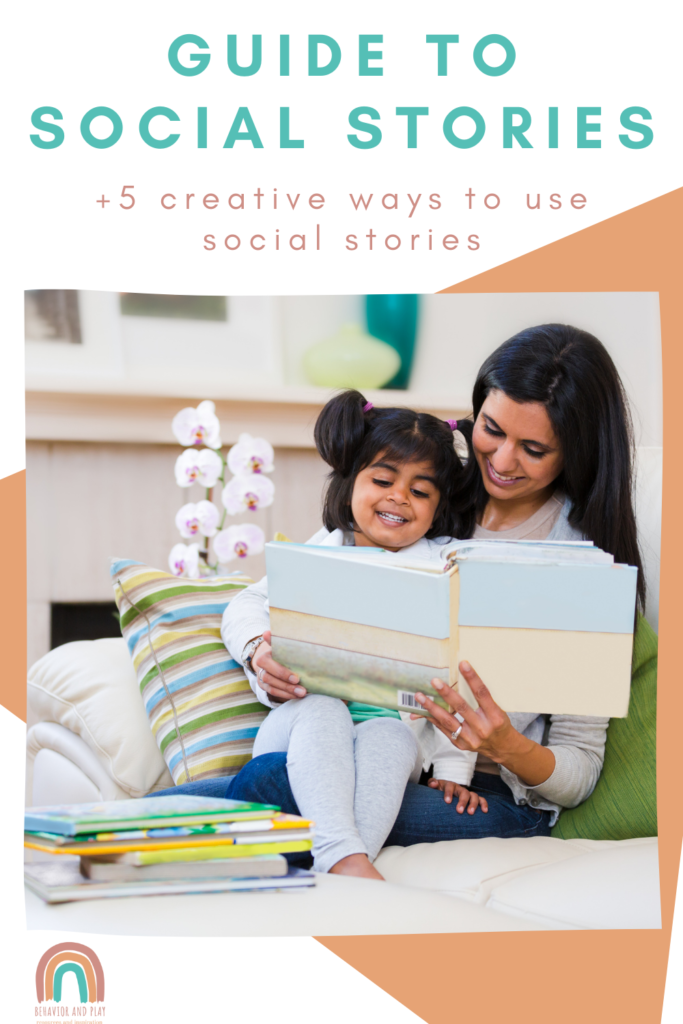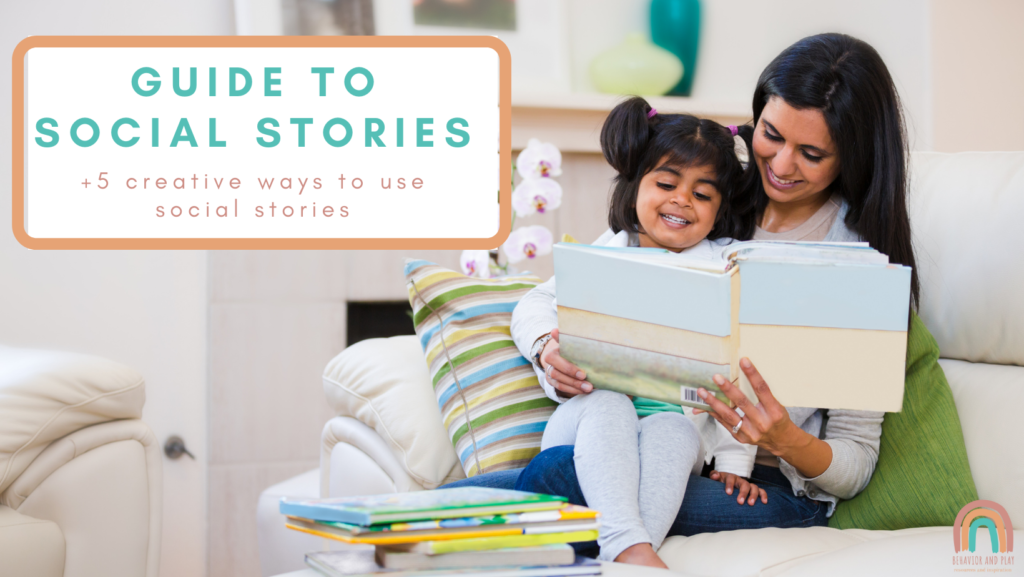Have you ever felt pressured in gatherings, anxious during times when you are in a crowd, or just felt like – well – nothing around you makes much sense. Take that familiar feeling and multiply it by 10 and you may come up with an idea how children with special needs experience different social situations. Navigating social situations can be challenging for just about anyone. Using social stories is an evidenced based practice to help promote positive change in handling social interactions.
What is a Social Story
Social Stories (TM) was developed and coined by Carol Gray in 1991. Gray (1995, 2000) expresses there is only one true definition of a Social Story:
“A Social Story accurately describes a context, skill, achievement, or concept according to 10 defining criteria. These criteria guide Story research, development, and implementation to ensure an overall patient and supportive quality, and a format, “voice”, content, and learning experience that is descriptive, meaningful, and physically, socially, and emotionally safe for the child, adolescent, or adult with autism.”
Gray, C What Is A Social Story
These short stories are a simple social learning tool which is often used as an effective way to help young people navigate their way through a complex situation. They are a great way to target a child’s individual needs and help young children develop different skills – like social skills and life skills – in a positive and supportive quality.

Take note, Social Stories do NOT fix behaviors – rather – protect the individual’s personal qualities and help them learn and develop new ways to deal with challenges. If you are dealing with very difficult behaviors, try adding social stories as a part of your behavior management plan. Learn more about anger management for children here.
Who are social stories for
Social stories are commonly used in special education by speech pathologists, school psychologists and counselors, and behavior consultants for younger children with special needs. It is used alongside other intervention strategies to help children with sensory processing disorder, Asperger’s syndrome, social behavior concerns, and people with autism of all ages through different situations.
What are the Benefits of Social Stories
Social stories help young children in many ways! It is very easy to forget that things which seem very easy and natural for us might be extremely challenging for children. These simple stories are a great way to help children learn new skills, pick up on social cues, teach social norms, practice social skills like how to be a good friend or dealing with uncomfortable situations, develop routines, and reduce anxiety.
Social stories can even help build on to your child’s strengths and help them find ways to solve problems through their strong suites.
How to Use Social Stories
The use of social stories are very simple and can be used during any given situation. The best way to use social stories is proactively – before target behavior is exhibited. For example, if your social story is all about going to an assembly, then reading the story days leading up to the assembly and just before the assembly would be ideal. Social story interventions are meant help develop a particular skill or address/prepare for a special events. Thus, the use of social story strategies is proactive by nature and can be very useful in helping a kiddo prepare for a rough time.
Some creative ways to use social stories can be:
- Visual schedules or visual supports for practicing routines – read the story beforehand as a reminder of what is expected
- Springbook (if that’s a word! like spring board haha) to role play and practice scenarios – act our the story after reading it
- A way to dissect visual cues as seen in story pictures – here you can go in the community or watch a show to find similar faces or situations found in the story
- Positive way to debrief after a bad day – rough days are inevitable! Because of the positive nature of social stories, by reading them after a bad day, you can remind the child that strong feelings are normal and that there are better ways to deal with them.
- Create a little book with social story chapters – this creates a highly customized book for a child with each short story made specifically for the world as it is to them.
Where Can I Get Social Stories
Carol Gray latest book, The New Social Story Book compiles 150 Social Stories, find the book here. Important information about Social Storiestm is provided in Carol Gray’s website around the official use of Social Stories (TM). However, practitioners and parents are able to create their own stories in the form of social scripts, social narratives, or social articles tailored for a child’s individual needs.
There are a handful of places to find free social stories for various situations (hello Pinterest!) that also offer free and paid options for printable social stories. Despite having all these resources, it is extremely beneficial to make unique social stories to cater to a child’s specific individual needs.
How to Write a Social Story
As a social stories creator, start by answering the question “what is the desired outcome of this story?”
The goal of your social script should be to teach a skill or common value. Think about a problem behavior that you want to replace or work on. I know that term is a bit negative, however, when I say problem behavior I simply mean any maladaptive behaviors surrounding any given situation. An example of this could be a child who gets over stimulated or refuses to go to assemblies. Problem behaviors do not necessarily have to end with aggression.
Next step, gather information. Here you need to jot down the key points to your goal. These key points include answering all the wh- questions like when and where does the the topic occur? Who is a part of the situation? What happens during the situation and why? And lastly, the how is the solution or appropriate behaviors surrounding the goal of your script.
Third, create your own social stories by giving it it’s own voice. Here is when you write the short story. There are a couple of guidelines you must follow in writing a social story whether or not you follow Gray’s criteria.
Guidelines to consider during the development of social stories:
- The story has an introduction (beginning), body (middle), and conclusion (end)
- Use literally accurate words
- Written in the first person
- Use positive language
- Provides accurate social information
- Utilize a 2-5 ratio of the sentences (let’s talk about these in a bit)
Types of sentences in social stories
- descriptive sentences – these are factual statements that focus on specific details
- perspective sentence – there include thoughts, beliefs, own feelings or possibly feelings of others
- directive sentence- usually written in future tense and describes the desired response, alternate or appropriate behaviour for specific situations
- affirmative sentences – this focuses on common values and provides reassurance and positive reinforcement to the recipient
Lastly, you need to have a clear title that teaches. When formulating the title to your social story, go back to step one and think about the goal of the story. Social stories are written in easy to understand, short and simple sentences, and are often direct to the point. Your title should be so too. For example, “The School Assembly” or “Billy goes to the school assembly” would be appropriate, straight forward titles that immediately tells Billy this story is going to teach him all about the school assembly.
Here is an example of a social story that talks about the Helper of the Day.
Helper of the Day
I have lots of friends at school. (Des)
Each day, teacher chooses a friend to be the Helper of the Day! (Des)
We take turns being the helper of the day. (Des)
The Helper of the Day get to do lots of things like making choices and be the line leader (Des)
We are happy for our friends who get to be the helper and my friends are happy for me when I am the helper too. (Aff)
If I am not chosen I might feel upset. This will make my friends sad. (Pers)
I can take a deep breather and remember it will be my turn some day too. (Dir)
I can show I am happy for my friend by clapping my hands or smiling. (Dir)
This makes everyone in the classroom happy. (Aff)
This particular social story was made for a student who struggled each time it was not his turn to be the helper of the day. The social story provided factual sentences describing the particular situation when and where the behavior occurs and who is involved. What happens during the situation and why is also provided in partial sentences written in the first person to describe how he feels. Lastly, the desired response and common value is presented in affirmative sentences, providing alternate behaviors that are acceptable.
The Power of a Story
It is worth considering that children may behave in certain ways because they do not know any way else to address the situation. Social stories are great ways to provide alternative responses that they might not have thought of.
This story was read for a couple of days at the beginning of circle time (before the helper of the day was chosen). With the guidance of the story and vicarious modeling, the child quickly adapted to the alternate response. This is the special power of social narratives in action! Stories will not play out like this at all times. This is also why they are usually a key element in a toolbox of strategies but hardly ever used alone.
Like this story? Download your free copy here.
Images for Social Stories
Images used in social stories vary based on personal preference. For personal use, you can simply search for clip art or stock photos to use in your own social stories. You can also consider using taking and using your own photos for a more personal touch that is more relatable. One creative way I like to do with my kiddos is to have them draw the pictures themselves! This is a really nice way to have them be involved and feel like the story is really tailored to their needs.
Resources
Carol Gray publications:
New Social Stories, Taming the Recess Jungle, and Comic Strip Con
Gray, C. A. (2000). The new social story bookTM. Arlington, TX: Future Horizons


Pingback: How To Identify And Understand The Four Functions Of Behavior - Behavior and Play